Andromeda Bot Analysis part 2
Bot Analysis:
Now, you get the original Andromeda build file. Load the unpacked sample at OllyDBG. As before, after the stack frame at the EP, you see that the malware is looking to load API's address using the PEB_LDR_DATA structure, but this time instead of kernel32.dll; the malware try to find ntdll.dll base address, then, it will parse the EAT, hash each APIs then make comparison to find the needed APIs :
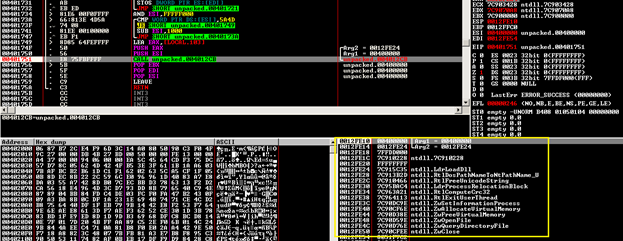
After getting inside the CALL, it will calculate the hash of a buffer located at 00402028:
def calc_hash(string):
return binascii.crc32(string) & 0xffffffff
Then, it compared it with 0xBD274BDB, if not matches, it calls RtlExitUserThread, we will figure out soon what kind of data has been hashed. Afterwards, ZwAllocateVirtualMemory will be called and return for me 7FFA0000 then the CALL at 00401343 will copy the whole buffer to the allocated space. Next, we see the CALL at VA 00401351 which takes 4 arguments and one of them is a pointer to our unknown buffer. This routine is actually preforming a RC4 encryption, you could recognize that by looking at the constants, this is how basically some cryptographic algorithm is detected; RC4 have loops that go till 256 which is 0x100 in hexadecimal.
Using ZwAllocateVirtualMemory again, we allocate a new memory space to the partially decrypted payload so it is finally decompressed using the aPLib-library. The code that follows is responsible for processing relocations and fixing imports. For instance, from NTDLL Andromeda is importing these APIs:
LdrLoadDll, RtlDosPathNameToNtPathName_U, RtlFreeUnicodeString, LdrProcessRelocationBlock, RtlComputeCrc32, RtlWalkHeap, RtlImageNtHeader, RtlImageDirectoryEntryToData, RtlExitUserThread, ZwSetInformationProcess, ZwUnmapViewOfSection, ZwAllocateVirtualMemory, ZwMapViewOfSection, ZwFreeVirtualMemory, ZwOpenFile, ZwQueryDirectoryFile, ZwClose, ZwQueryInformationProcess.
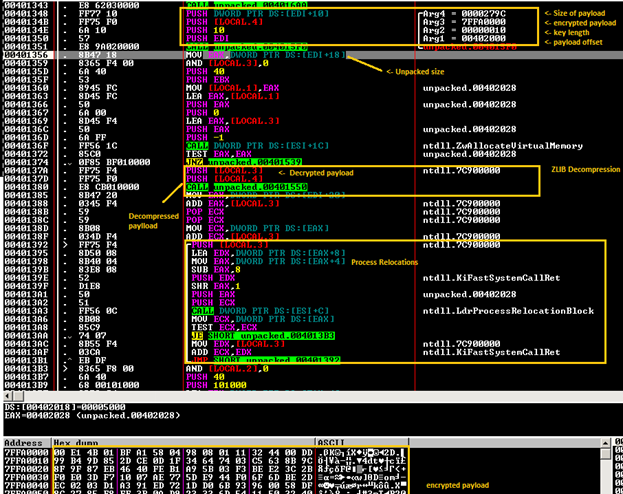
You can find a script here of an old version of Andromeda thanks to
0xEBFE. You still need to make some minor changes on it to get it works correctly particularly the APIs and Imports, which changed a bit:
[download]
from idaapi import *
from idautils import *
from aplib import decompress
import binascii
import struct
# hardcoding sucks :)
IMPORTS = { 'ntdll.dll' : ('ZwResumeThread', 'ZwQueryInformationProcess', 'ZwMapViewOfSection', 'ZwCreateSection', 'ZwClose', 'ZwUnmapViewOfSection', 'NtQueryInformationProcess', 'RtlAllocateHeap', 'RtlExitUserThread', 'RtlFreeHeap', 'RtlRandom','RtlReAllocateHeap', 'RtlSizeHeap', 'ZwQuerySection', 'RtlWalkHeap', 'NtDelayExecution'),
'kernel32.dll' : ('GetModuleFileNameW', 'GetThreadContext', 'GetWindowsDirectoryW', 'GetModuleFileNameA', 'CopyFileA', 'CreateProcessA', 'ExpandEnvironmentStringsA', 'CreateProcessW', 'CreateThread', 'CreateToolhelp32Snapshot', 'DeleteFileW','DisconnectNamedPipe', 'ExitProcess', 'ExitThread', 'ExpandEnvironmentStringsW', 'FindCloseChangeNotification', 'FindFirstChangeNotificationW,FlushInstructionCache', 'FreeLibrary', 'GetCurrentProcessId', 'GetEnvironmentVariableA', 'GetEnvironmentVariableW', 'GetExitCodeProcess', 'GetFileSize', 'GetFileTime', 'GetModuleHandleA', 'GetModuleHandleW', 'GetProcAddress', 'GetProcessHeap', 'CreateNamedPipeA', 'GetSystemDirectoryW', 'GetTickCount', 'GetVersionExA', 'GetVolumeInformationA', 'GlobalLock', 'GlobalSize', 'GlobalUnlock', 'LoadLibraryA', 'LoadLibraryW', 'LocalFree', 'MultiByteToWideChar', 'OpenProcess', 'OpenThread', 'QueueUserAPC', 'ReadFile', 'ResumeThread', 'SetCurrentDirectoryW', 'SetEnvironmentVariableA', 'SetEnvironmentVariableW', 'SetErrorMode', 'SetFileAttributesW', 'SetFileTime', 'SuspendThread', 'TerminateProcess', 'Thread32First', 'Thread32Next', 'VirtualAlloc', 'VirtualFree', 'VirtualProtect', 'VirtualQuery', 'WaitForSingleObject', 'WriteFile', 'lstrcatA', 'lstrcatW', 'lstrcmpiW', 'lstrcpyA', 'lstrcpyW', 'lstrlenA', 'lstrlenW', 'CreateFileW', 'CreateFileA', 'ConnectNamedPipe', 'CloseHandle', 'GetShortPathNameW'),
'advapi32.dll' : ('CheckTokenMembership', 'RegCloseKey', 'ConvertStringSidToSidA', 'ConvertStringSecurityDescriptorToSecurityDescriptorA', 'RegOpenKeyExA', 'RegSetValueExW', 'RegSetValueExA', 'RegSetKeySecurity', 'RegQueryValueExW', 'RegQueryValueExA', 'RegOpenKeyExW', 'RegNotifyChangeKeyValue', 'RegFlushKey', 'RegEnumValueW', 'RegEnumValueA', 'RegDeleteValueW', 'RegDeleteValueA', 'RegCreateKeyExW', 'RegCreateKeyExA'),
'ws2_32.dll' : ('connect', 'shutdown', 'WSACreateEvent', 'closesocket', 'WSAStartup', 'WSAEventSelect', 'socket', 'sendto', 'recvfrom', 'getsockname', 'gethostbyname', 'listen', 'accept', 'WSASocketA', 'bind', 'htons'),
'user32.dll' : ('wsprintfW', 'wsprintfA'),
'ole32.dll' : ('CoInitialize'),
'dnsapi.dll' : ('DnsWriteQuestionToBuffer_W', 'DnsRecordListFree', 'DnsExtractRecordsFromMessage_W')}
def calc_hash(string):
return binascii.crc32(string) & 0xffffffff
def rc4crypt(data, key):
x = 0
box = bytearray(range(256))
for i in range(256):
x = (x + box[i] + key[i % len(key)]) % 256
box[i], box[x] = box[x], box[i]
x,y = 0, 0
out = bytearray()
for byte in data:
x = (x + 1) % 256
y = (y + box[x]) % 256
box[x], box[y] = box[y], box[x]
out += bytearray([byte ^ box[(box[x] + box[y]) % 256]])
return out
def fix_payload_relocs_and_import(segment, relocs_offset):
current_offset = 0
# processing relocations
while True:
base = Dword(segment + relocs_offset + current_offset)
size = Dword(segment + relocs_offset + current_offset + 4)
if (base == 0 and current_offset != 0) or size == 0:
current_offset += 4
break
current_offset += 8
size = (size - 8) // 2
for i in range(size):
reloc = Word(segment + relocs_offset + current_offset)
if reloc & 0x3000:
reloc = reloc & 0xFFF
PatchDword(segment + base + reloc, Dword(segment + base + reloc) + segment)
SetFixup(segment + base + reloc, idaapi.FIXUP_OFF32 or idaapi.FIXUP_CREATED, 0, Dword(segment + base + reloc) + segment, 0)
current_offset += 2
# processing imports
while True:
module_hash = Dword(segment + relocs_offset + current_offset)
import_offset = Dword(segment + relocs_offset + current_offset + 4)
current_offset += 8
if module_hash == 0 or import_offset == 0:
break
module = None
for library in iter(IMPORTS):
if module_hash == calc_hash(library.lower()):
module = library
while True:
func_hash = Dword(segment + relocs_offset + current_offset)
current_offset += 4
if func_hash == 0:
break
if module is not None:
for function in iter(IMPORTS[module]):
if func_hash == calc_hash(function):
MakeDword(segment + import_offset)
MakeName(segment + import_offset, SegName(segment) + '_' + module.split('.')[0] + '_' + function)
else:
print('Import not found: module = 0x{0:08X}, function = 0x{1:08X}'.format(module_hash, func_hash))
import_offset += 4
return
def decrypt_payload(encrypted_addr, rc4key, encrypted_size, unpacked_size, entry_point, relocs, relocs_size):
buffer = bytearray(encrypted_size)
for i in range(len(buffer)):
buffer[i] = Byte(encrypted_addr + i)
decrypted = rc4crypt(buffer, rc4key)
unpacked = decompress(str(decrypted)).do()
# checking for free segment address
seg_start = 0x10000000
while SegName(seg_start) != '':
seg_start += 0x10000000
AddSeg(seg_start, seg_start + unpacked_size, 0, 1, idaapi.saRelPara, idaapi.scPub)
# copying data to new segment
data = unpacked[0]
for i in range(len(data)):
PatchByte(seg_start + i, ord(data[i]))
fix_payload_relocs_and_import(seg_start, relocs)
MakeFunction(seg_start + entry_point)
return
def main():
payload_addr = AskAddr(ScreenEA(), "Enter address of andromeda payload")
if payload_addr != idaapi.BADADDR and payload_addr is not None:
payload = bytearray(0x28)
for i in range(len(payload)):
payload[i] = Byte(payload_addr + i)
dwords = struct.unpack_from('<LLLLLL', bytes(payload), 0x10)
decrypt_payload(payload_addr + 0x28, payload[:16], dwords[0], dwords[2], dwords[3], dwords[4], dwords[5])
if __name__ == '__main__':
main()
At the end, you see the call to: 00401532 |. FFD0 CALL EAX
This will transfer the control to the payload. Here is a screenshot about the payload decrypted.
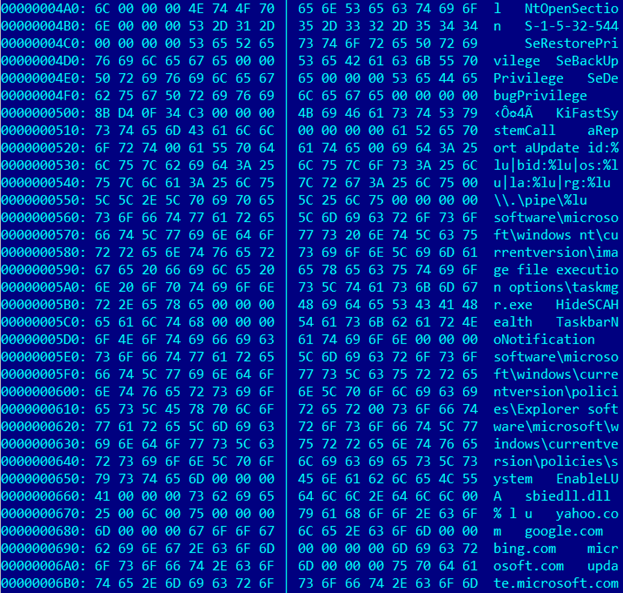
The next step shows anti-analysis tricks that are employed. The call at VA 7FF91408 is iterating through process names and computing their CRC32 hash values: if a hash value matches any of those on a list of hash values of VM processes and monitoring tools like wireshark.exe, etc., this indicates that the debugging process is inside a sandbox environment or being monitored.

Furthermore, this trick is not changed. As in version 2.07 and 2.08, the 2.09 version continues to calculate the CRC32 hash of the volume name of drive C:, which is then compared with the hardcoded value 0x20C7DD84. If you get caught, you will run in infinite loop that call ZwDelayExecution ! just patch the JNZ after the call or put RET in ZwDelayExecution.

After that I think that the CALL at VA 7FF91420 is trying to setup a KiFastSystemCall hook, this API is the lowest level API available in the "usermode" layer aka Ring3, all application' calls pass from KiFastSystemCall, which redirects all those controls onto the Windows Kernel via an instruction called SYSENTER.
Next, because processes run by the user can't do everything like writing in explorer.exe memory, the malware is trying to use SeDebugPrivilege and calling ZwAdjustTokenPrivilege to escalate to System privileges. It calls the SetEnvironmentVariableW API to save the original bot's full path to the environment variable. Afterwards, it comes the injection process, depending if you have a 32 or a 64 bits operating system, the malware will launch a hallowed version of msiexe.exe and inject its code there:
Code Injection:
The injection process involves several steps:
As with the previous versions, the malware calls CreateFile to get the handle of the file it wants to inject. It then gets its section handle by calling ZwCreateSection, which is used by ZwMapViewOfSection to get the image of the file in memory. From this image, it extracts the size of image and the address of the entry point from the PE header.
A memory address with the same size as that of the image of the file that it wants to inject is created with PAGE_EXECUTE_READWRITE access. Then the image of the file is copied over to this memory address.
Another memory address is created with the same size as that of the image of the original bot file, also with PAGE_EXECUTE_READWRITE access. The original file is then copied over to this new memory address.
A suspended process of the file to be injected is created. The memory address containing the original file is unmapped. ZwMapViewOfSection is called with the bot's file handle and the process handle (acquired from creating the suspended file process). So now the injected file's process handle has a map view of the botnet file. The final step is the call to ZwResumeThread, which resume the process.
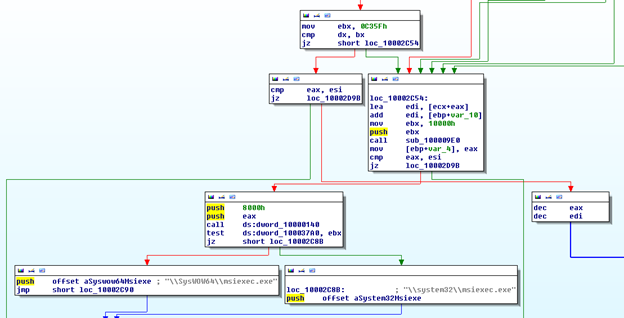
If the User is an admin, it checks that with CheckTokenMemberShip, it installes into "%ALLUSERPROFILE%" and autostarts using an uncommon Registry Path "softwaremicrosoftwindowscurrentversionPoliciesExplorerRun" - with a random Key name. If not it only installs into "%USERPROFILE%".

CnC Communication:
Before establishing a connection, the bot prepares the message to be sent to the C&C server. It uses the following format: id:%lu|bid:%lu|os:%lu|la:%lu|rg:%lu
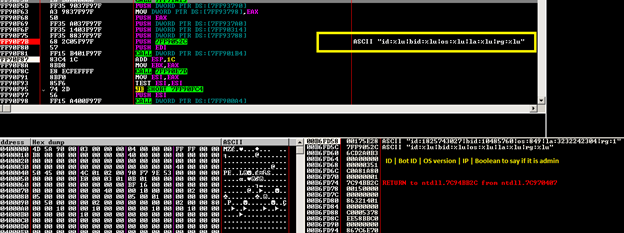
This string is encrypted using RC4 with a hard-coded key of length 0x20 and is further encoded using base64. The message is then sent to the server. Once a message is received, the bot calculates the CRC32 hash of the message without including the first DWORD. If the calculated hash matches the first DWORD, the message is valid. Later it is decrypted using RC4 with the VolumeSerialNumber as the key. After the RC4 decryption the message is in the format gn([base64-encoded string]). This used to be just the base64-encoded string, but for some reason the author decided not to make the server backward compatible with the older bot versions. Then it decodes the base64 string inside the brackets to get the message in plain text.

The first DWORD of the message is used as a multiplier to multiply a value in a fixed offset. The DWORD in that offset is used as an interval to delay calling the thread again to establish another connection. The next byte indicates what action to carry out - there are seven options:
- Case 1 (download EXE): Connect to the domain decrypted from the message to download an EXE file. Save the file to the %tmp% location with a random name and run the process.
- Case 2 (load plug-ins): Connect to the domain decrypted from the message, install and load plug-ins. The plug-ins are decrypted by RC4 using the same key of length 0x20h.
- Case 3 (update case): Connect to the domain to get the update EXE file. If a file name of VolumeSerialNumber is present in theregistry, then save the PE file to the %tmp% location with a random name; else save it to the current location with the name of the file as VolumeSerialNumber. The file in %tmp% is run, while the current process terminates. It also sends the message 'kill' xor'ed by VolumeSerialNumber to terminate the older process.
- Case 4 (download DLL): Connect to the domain and save the DLL file to the %alluserprofile% location. The file is saved as a .dat file with a random name and loaded from a specified export function. The registry is modified so it can be auto-loaded by the bot.
- Case 5 (delete DLLs): Delete and uninstall all the DLLs loaded and installed in Case 4.
- Case 6 (delete plug-ins): Uninstall all the plug-ins loaded in Case 3.
- Case 7 (uninstall bot): Suspend all threads and uninstall the bot.
- After executing the action based on which instruction it received, another message is sent to the server to notify it that the action has been completed:
id:%lu|tid:%lu|res:%lu
- id is the VolumeSerialNumber
- tid is the next byte (task id) after the byte displaying the case number in the message received
- res is the result of whether or not the task was carried out successfully.
Once the message has been sent, the thread exits and waits for the delay interval period to pass before it reconnects to the server to receive additional instructions.
Conclusion:
Andromeda's current version 2.09 increased the barriers that it has set up for security researchers. The new features raise additional difficulty for analysis, but are still easy to skip.
We anticipate that the Andromeda botnet will keep on evolving. Our botnet monitoring system is continuing to track its activities and we will respond immediately when it enters its next generation.







